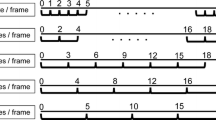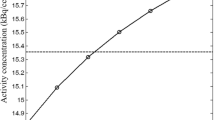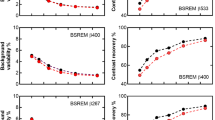Abstract
Objective
Positron emission tomography allows imaging of patho-physiological information as a form of rate constants from scanned and reconstructed dynamic image. Some reconstruction algorithms incorporated with time of flight and point spread function have been developed, and quantitative accuracy and quality in the image have been investigated. However, feasibility of the rate constants from the dynamic image has not been directly investigated. We investigated the accuracy and quality in the rate constant by scanning a phantom filled simultaneously with 11C and 18F.
Method
We utilized a phantom filled with 18F–F− solution in the main cylinder and with 11C-flumazenil solution in seven sub-cylinders. The phantom was scanned by a Biograph mCT and the scanned data were reconstructed with FBP- and OSEM-based algorithms incorporating with and without TOF and/or PSF corrections. Decay rate images as kinetic rate constant were computed for all the reconstructed images and quantitative accuracy and quality in the rate images were investigated.
Results
The obtained decay rates were not significantly different from the reference values for both isotopes for all applied algorithms when noise on image was not large. Respective SD was smaller in OSEM with TOF in the 11C-filled region.
Conclusion
The present study suggests that OSEM incorporating with TOF provides reasonable quantitative accuracy and image quality regarding decay rates.





Similar content being viewed by others
References
Watabe H, Ikoma Y, Kimura Y, Naganawa M, Shidahara M. PET kinetic analysis—compartmental model. Ann Nucl Med. 2006;20:583–8.
Peng H, Levin CS. Recent developments in PET instrumentation. Curr Pharm Biotechnol. 2010;11:555–71.
Tong S, Alessio AM, Kinahan PE. Image reconstruction for PET/CT scanners: past achievements and future challenges. Imaging Med. 2010;2:529–45.
Boellaard R, van Lingen A, Lammertsma AA. Experimental and clinical evaluation of iterative reconstruction (OSEM) in dynamic PET: quantitative characteristics and effects on kinetic modeling. J Nucl Med. 2001;42:808–17.
Lubberink M, Boellaard R, van der Weerdt AP, Visser FC, Lammertsma AA. Quantitative comparison of analytic and iterative reconstruction methods in 2- and 3-dimensional dynamic cardiac 18F-FDG PET. J Nucl Med. 2004;45:2008–15.
Søndergaard HM, Boisen K, Bøttcher M, Schmitz O, Nielsen TT, Bøtker HE, et al. Evaluation of iterative reconstruction (OSEM) versus filtered back-projection for the assessment of myocardial glucose uptake and myocardial perfusion using dynamic PET. Eur J Nucl Med Mol Imaging. 2007;34:320–9.
Surti S, Kuhn A, Werner ME, Perkins AE, Kolthammer J, Karp JS. Performance of Philips Gemini TF PET/CT scanner with special consideration for its time-of-flight imaging capabilities. Nucl Med. 2007;48:471–80.
Jakoby BW, Bercier Y, Conti M, Casey ME, Bendriem B, Townsend DW. Physical and clinical performance of the mCT time-of-flight PET/CT scanner. Phys Med Biol. 2011;56:2375.
Bettinardi V, Presotto L, Rapisarda E, Picchio M, Gianolli L, Gilardi MC. Physical performance of the new hybrid PET/CT discovery-690. Med Phys. 2011;38:5394–441.
Panin VY, Kehren F, Michel C, Casey M. Fully 3-D PET reconstruction with system matrix derived from point source measurements. IEEE Trans Med Imaging. 2006;25:907–21.
Tong S, Alessio AM, Kinahan PE. Noise and signal properties in PSF-based fully 3D PET image reconstruction: an experimental evaluation. Phys Med Biol. 2010;55:1453–73.
Lois C, Jakoby BW, Long MJ, Hubner KF, Barker DW, Casey ME, et al. An assessment of the impact of incorporating time-of- flight (TOF) information into clinical PET/CT imaging. J Nucl Med. 2010;51:237–45.
Akamatsu G, Mitsumoto K, Taniguchi T, Tsutsui Y, Baba S, Sasaki M. Influences of point-spread function and time-of-flight reconstructions on standardized uptake value of lymph node metastases in FDG-PET. Eur J Radiol. 2014;83:226–30.
Watson CC. New, faster, image-based scatter correction for 30 PET. IEEE Trans Nucl Sci. 2000;47:1587–94.
Akamatsu G, Ishikawa K, Mitsumoto K, Taniguchi T, Ohya N, Baba S, et al. Improvement in PET/CT image quality with a combination of point-spread function and time-of-flight in relation to reconstruction parameters. J Nucl Med. 2012;53:1716–22.
Koeppe RA, Holden JE, Ip WR. Performance comparison of parameter estimation techniques for the quantitation of local cerebral blood flow by dynamic positron computed tomography. J Cereb Blood Flow Metab. 1985;5:224–34.
Phelps ME, Huang SC, Hoffman EJ, Selin C, Sokoloff L, Kuhl DE. Tomographic measurement of local cerebral glucose metabolic rate in humans with (F-18) 2-fluoro-2-deoxy-d-glucose: validation of method. Ann Neurol. 1979;6:371–88.
Koeppe RA, Holthoff VA, Frey KA, Kilbourn MR, Kuhl DE. Compartmental analysis of [11C]flumazenil kinetics for the estimation of ligand transport rate and receptor distribution using positron emission tomography. J Cereb Blood Flow Metab. 1991;11:735–44.
Schiepers C, Dahlbom M, Chen W, Cloughesy T, Czernin J, Phelps ME, et al. Kinetics of 3′-deoxy-3′-18F-fluorothymidine during treatment monitoring of recurrent high-grade glioma. J Nucl Med. 2010;51:720–7.
Gunn RN, Lammertsma AA, Hume SP, Cunningham VJ. Parametric imaging of ligand-receptor binding in PET using a simplified reference region model. Neuroimage. 1997;6:279–87.
Watabe H, Jino H, Kawachi N, Teramoto N, Hayashi T, Ohta Y, Iida H. Parametric imaging of myocardial blood flow with 15O-water and PET using the basis function method. J Nucl Med. 2005;46:1219–24.
Boellaard R, Knaapen P, Rijbroek A, Luurtsema GJ, Lammertsma AA. Evaluation of basis function and linear least squares methods for generating parametric blood flow images using 15O-water and positron emission tomography. Mol Imaging Biol. 2005;7:273–85.
Kudomi N, Koivuviita N, Liukko KE, Oikonen VJ, Tolvanen T, Iida H, et al. Parametric renal blood flow imaging using [15O]H2O and PET. Eur J Nucl Med Mol Imaging. 2009;36:683–91.
Kudomi N, Hirano Y, Koshino K, Hayashi T, Watabe H, Fukushima K, et al. Rapid quantitative CBF and CMRO2 measurements from a single PET scan with sequential administration of dual 15O-labeled tracers. J Cereb Blood Flow Metab. 2013;33:440–8.
Hudson HM, Larkin RS. Accelerated image-reconstruction using ordered subsets of projection data. IEEE Trans Med Imaging. 1994;13:601–9.
Liow JS, Strother SC, Rehm K, Rottenberg DA. Improved resolution for PET volume imaging through three-dimensional iterative reconstruction. J Nucl Med. 1997;38:1623–31.
Bai B, Esser PD. The effect of edge artifacts on quantification of positron emission tomography. In: IEEE nuclear science symposium and medical imaging conference record. 2010; pp 2263–6.
Nakamura A, Tanizaki Y, Takeuchi M, Ito S, Sano Y, Sato M, et al. Impact of point spread function correction in standardized uptake value quantitation for positron emission tomography images: a study based on phantom experiments and clinical images. Nihon Hoshasen Gijutsu Gakkai Zasshi. 2014;70:542–8.
Acknowledgments
The authors thank the staff at Department of Clinical Radiology in our University Hospital and at Department of Medical Physics in our University. The work of NK was supported by the Ministry of Education, Science, Sports and Culture of Japan, a grant-in-aid for JSPS KAKENHI (C) Grant number 26460728 (2014–2017).
Author information
Authors and Affiliations
Corresponding author
Rights and permissions
About this article
Cite this article
Maeda, Y., Kudomi, N., Yamamoto, H. et al. Image accuracy and quality test in rate constant depending on reconstruction algorithms with and without incorporating PSF and TOF in PET imaging. Ann Nucl Med 29, 561–569 (2015). https://doi.org/10.1007/s12149-015-0979-1
Received:
Accepted:
Published:
Issue Date:
DOI: https://doi.org/10.1007/s12149-015-0979-1




